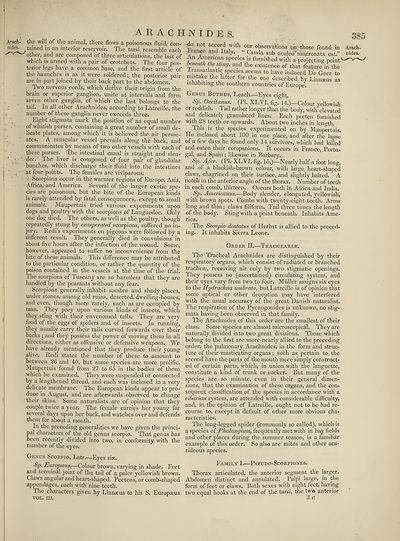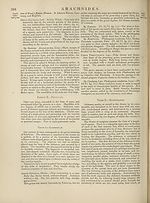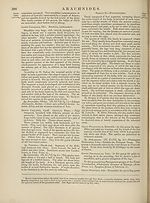Encyclopaedia Britannica > Volume 3, Anatomy-Astronomy
(393) Page 385
Download files
Complete book:
Individual page:
Thumbnail gallery: Grid view | List view

i
arachnides.
Arach¬
nides.
the will of the animal, there flows a poisonous fluid, con-
tained in an interior reservoir. The tarsi resemble each
'other, and are composed of three articulations, the last of
which is armed with a pair of crotchets. The four pos¬
terior legs have a common base, and the first article of
the haunches is as it were soldered; the posterior pair
are in part joined by their back part to the abdomen.
Two nervous cords, which derive their origin from the
brain or superior ganglion, unite at intervals and form
seven other ganglia, of which the last belongs to the
tail. In all other Arachnides, according to Latreille, the
number of these ganglia never exceeds three.
Eight stigmata mark the position of an equal number
of whitish purses, containing a great number of small de¬
licate plates, among which it is believed the air perme¬
ates. A muscular vessel prevails along the back, and
communicates by means of two other vessels with each of
these purses. The intestinal canal is straight and slen¬
der. The liver is composed of four pair of glandular
bunches, which discharge their fluid into the intestines
at four points. The females are viviparous.
. Scorpions occur in the warmer regions of Europe, Asia,
Africa, and America. Several of the larger exotic spe¬
cies are poisonous, but the bite of the European kinds
is rarely attended by fatal consequences, except to small
animals. Maupertuis tried various experiments upon
dogs and poultry with the scorpions of Languedoc. Only
one dog died. The others, as well as the poultry, though
repeatedly stung by exasperated scorpions, suffered no in¬
jury. Redi’s experiments on pigeons were followed by a
different result. They generally died in convulsions in
about five hours after the infliction of the wound. Some,
however, appeared to suffer no inconvenience from the
bite of these animals. This difference may be attributed
to the particular condition, or rather the quantity of the
poison contained in the vessels at the time of the trial.
The scorpions of Tuscany are so harmless that they are
handled by the peasants without any fear.
Scorpions generally inhabit sombre and shady places,
under stones, among old ruins, deserted, dwelling-houses,
and even, though more rarely, such as are occupied by
man. They prey upon various kinds of insects, which
they sting with their envenomed tails. They are very
fond of the eggs of spiders and of insects. In running,
they usually carry their tails curved forwards over their
backs; and they possess the power of moving them in all
directions, either as offensive or defensive weapons. We
have already mentioned that they produce their young
alive. Redi states the number of these to amount to
between 26 and 40, but some species are more prolific.
Maupertuis found from 27 to 65 in the bodies of those
which he examined. They were suspended or connected
by a lengthened thread, and each was inclosed in a very
delicate membrane. The European kinds appear to pro¬
duce in August, and are afterwards observed to change
their skins. Some naturalists are of opinion that they
couple twice a year. The female carries her young for
several days upon her back, and watches over and defends
them for about a month.
In the preceding generalities we have given the princi¬
pal characters of the old genus Scorpio. That genus has
been recently divided into two, in conformity with the
number of the eyes.
Genus Scorpio, Latr.—Eyes six.
Sp. Europteus.—Colour brown, varying in shade. Feet
and terminal joint of the tail of a paler yellowish brown.
Claws angular and heart-shaped. Pectens, or comb-shaped
appendages, each with nine teeth.
Ihe characters given by Linnaeus to his S. Europaeus
VOL. in.
do not accord with our observations on those found in
prance an Italy. . “ Cauda sub aculeo mucronata est.”
An American species is furnished with a projecting point''
faneat/i the sting, and the existence of that feature^in the
transatlantic species seems to have induced De Geer to
mistake the latter for the one described by Linnseus as
inhabiting the southern countries of Europe.
Genus Buthus, Leach.—Eyes eight.
Sp. Occitanus. (PI. XLVI. fig. 14.)—Colour yellowish
or reddish. Tail rather longer than the body, with elevated
and delicately granulated lines. Each pecten furnished
with 28 teeth or upwards. About two inches in length.
This is the species experimented on by Maupertuis.
He inclosed about 100 in one place, and after the lapse
of a few days he found only 14 survivors, which had killed
and eaten their companions. It occurs in France, Portu¬
gal, and Spain ; likewise in Barbary.
Sp- Afer. (PL XLVI. fig. 15.)—Nearly half a foot long,
and of a blackish-brown colour, with large heart-shaped
claws, chagrined on their surface, and slightly haired. A
notch in the anterior angle of the thorax. Number of teeth
in each comb, thirteen. Occurs both in Africa and India.
Sp. Americanus.—Body slender, elongated, yellowish,
with brown spots. Combs with twenty-eight teeth. Arms
long and thin; claws filiform. Tail three times the length
of the body. Sting with a point beneath. Inhabits Ame¬
rica.
The Scorpio dentatus of Herbst is allied to the preced¬
ing. It inhabits Sierra Leone.
Order II.—Tracheari^e.
The Tracheal Arachnides are distinguished by their
respiratory organs, which consist of radiated or branched
tracheae, receiving air only by two stigmatic openings.
They possess no (ascertained) circulating system, and
their eyes vary from two to four. Muller assigns six eyes
to the Hydrachna umbrata, but Latreille is of opinion that
some optical or other deception may have interfered
with the usual accuracy of the great Danish naturalist.
The respiration of the Pycnogonides is unknown, no stig¬
mata having been observed in that family.
The Arachnides of this order are the smallest of their
class. Some species are almost microscopical. They are
naturally divided into two great divisions. Those which
belong to the first are more-nearly allied to the preceding
order, the pulmonary Arachnides, in the form and struc¬
ture of their masticating organs; such as pertain to the
second have the parts of the mouth more simply construct¬
ed of certain parts, which, in union with the languette,
constitute a kind of trunk or sucker. But many of the
species are so minute, even in their general dimen¬
sions, that the examination of these organs, and the con¬
sequent classification of the species in accordance with a
cibarian system, are attended with considerable difficulty,
and, in the opinion of Latreille, ought not to be had re¬
course to, except in default of other more obvious cha¬
racteristics.
The long-legged spider (commonly so called), which is
a species of Phalangium, frequently met with in hay fields
and other places during the summer season, is a familiar
example of this order. So also are mites and other aca-
rideous species.
Family I.—Pseudo-Scorpiones.
Thorax articulated, the anterior segment the larger.
Abdomen distinct and annulated. Palpi large, in the
form of feet or claws. Both sexes with eight feet, having
two equal hooks at the end of the tarsi, the two anterior
1 3 G
385
Arach¬
nides.
arachnides.
Arach¬
nides.
the will of the animal, there flows a poisonous fluid, con-
tained in an interior reservoir. The tarsi resemble each
'other, and are composed of three articulations, the last of
which is armed with a pair of crotchets. The four pos¬
terior legs have a common base, and the first article of
the haunches is as it were soldered; the posterior pair
are in part joined by their back part to the abdomen.
Two nervous cords, which derive their origin from the
brain or superior ganglion, unite at intervals and form
seven other ganglia, of which the last belongs to the
tail. In all other Arachnides, according to Latreille, the
number of these ganglia never exceeds three.
Eight stigmata mark the position of an equal number
of whitish purses, containing a great number of small de¬
licate plates, among which it is believed the air perme¬
ates. A muscular vessel prevails along the back, and
communicates by means of two other vessels with each of
these purses. The intestinal canal is straight and slen¬
der. The liver is composed of four pair of glandular
bunches, which discharge their fluid into the intestines
at four points. The females are viviparous.
. Scorpions occur in the warmer regions of Europe, Asia,
Africa, and America. Several of the larger exotic spe¬
cies are poisonous, but the bite of the European kinds
is rarely attended by fatal consequences, except to small
animals. Maupertuis tried various experiments upon
dogs and poultry with the scorpions of Languedoc. Only
one dog died. The others, as well as the poultry, though
repeatedly stung by exasperated scorpions, suffered no in¬
jury. Redi’s experiments on pigeons were followed by a
different result. They generally died in convulsions in
about five hours after the infliction of the wound. Some,
however, appeared to suffer no inconvenience from the
bite of these animals. This difference may be attributed
to the particular condition, or rather the quantity of the
poison contained in the vessels at the time of the trial.
The scorpions of Tuscany are so harmless that they are
handled by the peasants without any fear.
Scorpions generally inhabit sombre and shady places,
under stones, among old ruins, deserted, dwelling-houses,
and even, though more rarely, such as are occupied by
man. They prey upon various kinds of insects, which
they sting with their envenomed tails. They are very
fond of the eggs of spiders and of insects. In running,
they usually carry their tails curved forwards over their
backs; and they possess the power of moving them in all
directions, either as offensive or defensive weapons. We
have already mentioned that they produce their young
alive. Redi states the number of these to amount to
between 26 and 40, but some species are more prolific.
Maupertuis found from 27 to 65 in the bodies of those
which he examined. They were suspended or connected
by a lengthened thread, and each was inclosed in a very
delicate membrane. The European kinds appear to pro¬
duce in August, and are afterwards observed to change
their skins. Some naturalists are of opinion that they
couple twice a year. The female carries her young for
several days upon her back, and watches over and defends
them for about a month.
In the preceding generalities we have given the princi¬
pal characters of the old genus Scorpio. That genus has
been recently divided into two, in conformity with the
number of the eyes.
Genus Scorpio, Latr.—Eyes six.
Sp. Europteus.—Colour brown, varying in shade. Feet
and terminal joint of the tail of a paler yellowish brown.
Claws angular and heart-shaped. Pectens, or comb-shaped
appendages, each with nine teeth.
Ihe characters given by Linnaeus to his S. Europaeus
VOL. in.
do not accord with our observations on those found in
prance an Italy. . “ Cauda sub aculeo mucronata est.”
An American species is furnished with a projecting point''
faneat/i the sting, and the existence of that feature^in the
transatlantic species seems to have induced De Geer to
mistake the latter for the one described by Linnseus as
inhabiting the southern countries of Europe.
Genus Buthus, Leach.—Eyes eight.
Sp. Occitanus. (PI. XLVI. fig. 14.)—Colour yellowish
or reddish. Tail rather longer than the body, with elevated
and delicately granulated lines. Each pecten furnished
with 28 teeth or upwards. About two inches in length.
This is the species experimented on by Maupertuis.
He inclosed about 100 in one place, and after the lapse
of a few days he found only 14 survivors, which had killed
and eaten their companions. It occurs in France, Portu¬
gal, and Spain ; likewise in Barbary.
Sp- Afer. (PL XLVI. fig. 15.)—Nearly half a foot long,
and of a blackish-brown colour, with large heart-shaped
claws, chagrined on their surface, and slightly haired. A
notch in the anterior angle of the thorax. Number of teeth
in each comb, thirteen. Occurs both in Africa and India.
Sp. Americanus.—Body slender, elongated, yellowish,
with brown spots. Combs with twenty-eight teeth. Arms
long and thin; claws filiform. Tail three times the length
of the body. Sting with a point beneath. Inhabits Ame¬
rica.
The Scorpio dentatus of Herbst is allied to the preced¬
ing. It inhabits Sierra Leone.
Order II.—Tracheari^e.
The Tracheal Arachnides are distinguished by their
respiratory organs, which consist of radiated or branched
tracheae, receiving air only by two stigmatic openings.
They possess no (ascertained) circulating system, and
their eyes vary from two to four. Muller assigns six eyes
to the Hydrachna umbrata, but Latreille is of opinion that
some optical or other deception may have interfered
with the usual accuracy of the great Danish naturalist.
The respiration of the Pycnogonides is unknown, no stig¬
mata having been observed in that family.
The Arachnides of this order are the smallest of their
class. Some species are almost microscopical. They are
naturally divided into two great divisions. Those which
belong to the first are more-nearly allied to the preceding
order, the pulmonary Arachnides, in the form and struc¬
ture of their masticating organs; such as pertain to the
second have the parts of the mouth more simply construct¬
ed of certain parts, which, in union with the languette,
constitute a kind of trunk or sucker. But many of the
species are so minute, even in their general dimen¬
sions, that the examination of these organs, and the con¬
sequent classification of the species in accordance with a
cibarian system, are attended with considerable difficulty,
and, in the opinion of Latreille, ought not to be had re¬
course to, except in default of other more obvious cha¬
racteristics.
The long-legged spider (commonly so called), which is
a species of Phalangium, frequently met with in hay fields
and other places during the summer season, is a familiar
example of this order. So also are mites and other aca-
rideous species.
Family I.—Pseudo-Scorpiones.
Thorax articulated, the anterior segment the larger.
Abdomen distinct and annulated. Palpi large, in the
form of feet or claws. Both sexes with eight feet, having
two equal hooks at the end of the tarsi, the two anterior
1 3 G
385
Arach¬
nides.
Set display mode to:
![]() Universal Viewer |
Universal Viewer | ![]() Mirador |
Large image | Transcription
Mirador |
Large image | Transcription
Images and transcriptions on this page, including medium image downloads, may be used under the Creative Commons Attribution 4.0 International Licence unless otherwise stated. ![]()
| Encyclopaedia Britannica > Encyclopaedia Britannica > Volume 3, Anatomy-Astronomy > (393) Page 385 |
|---|
| Permanent URL | https://digital.nls.uk/193762457 |
|---|
| Attribution and copyright: |
|
|---|---|
| Shelfmark | EB.16 |
|---|---|
| Description | Ten editions of 'Encyclopaedia Britannica', issued from 1768-1903, in 231 volumes. Originally issued in 100 weekly parts (3 volumes) between 1768 and 1771 by publishers: Colin Macfarquhar and Andrew Bell (Edinburgh); editor: William Smellie: engraver: Andrew Bell. Expanded editions in the 19th century featured more volumes and contributions from leading experts in their fields. Managed and published in Edinburgh up to the 9th edition (25 volumes, from 1875-1889); the 10th edition (1902-1903) re-issued the 9th edition, with 11 supplementary volumes. |
|---|---|
| Additional NLS resources: |
|

